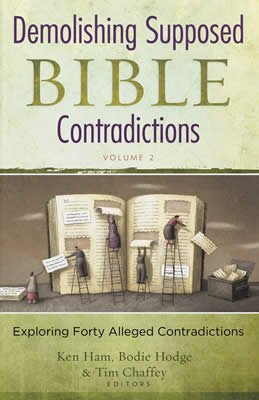
Balancing the Budget
2 Samuel and 1 Chronicles seem to claim that David paid different prices to different individuals for the site of the temple.
Kyle Runge, AiG–U.S., explains why 2 Samuel and 1 Chronicles seem to claim that David paid different prices to different individuals for the site of the temple.
The “Problem”
The account of David’s census of the Israelites is found both at the end of 2 Samuel and in chapter 21 of 1 Chronicles. In each account we are told that the census angered God and that He offered David a choice between three punishments: famine, war, or plague. David chose plague at the hands of the God he knew to be just instead of placing himself at the mercy of wicked men or starvation for his people.
God sent an angel to execute His judgment, and not long after, He sent word to David through a prophet named Gad that he should build an altar to God at a certain place to end the plague. David went up to the threshing floor of the man Gad had specified and bought the man’s floor, tools, and oxen, along with the surrounding land.
Here is where the two records appear to disagree. Note the differences in the following passages:
Then the king said to Araunah, “No, but I will surely buy it from you for a price; nor will I offer burnt offerings to the Lord my God with that which costs me nothing.” So David bought the threshing floor and the oxen for fifty shekels of silver. (2 Samuel 24:24)
Then King David said to Ornan, “No, but I will surely buy it for the full price, for I will not take what is yours for the Lord, nor offer burnt offerings with that which costs me nothing.” So David gave Ornan six hundred shekels of gold by weight for the place. (1 Chronicles 21:24–25)
So we appear to be faced with not one but two problems: What was the name of the man who owned the land? And, how much did David pay him?
The Solution
In response to the first question, there are at least two strong possibilities. It may be that Ornan also went by the name Araunah, just like many others in that culture. Another plausible solution is that, in the original Hebrew, one of these names is simply a variant spelling of the other. This is suggested in Strong’s Lexicon, which identifies Araunah as an “orthographical variation” of Ornan.1
As to the second problem, it would seem we have two very different amounts for almost the same purchase. It’s nearly impossible to imagine either David or the owner of the threshing floor confusing 50 shekels of silver (~$1,067 today) with 600 of gold (~$594,198), and so it would appear as if those believing the Bible to be untrustworthy were vindicated. After all, if such a gross error has been made in mere record-keeping, then what hope is there for the reliability of more complicated passages? If such an oversight is excusable, then aren’t reports of miracles hopelessly suspect? Sadly, as fallen human beings these are often our first thoughts as we repeat the mistake of the Jewish people in believing God to be “altogether like
[us]” (Psalm 50:21). If we instead allow Scripture to inform our thoughts and look back at the overall account more closely, we should notice that in both records David is offered the entire portion for free but refuses to accept it. David, in recognizing his need for atonement before God, declares that he will not offer a sacrifice that has, in his words, “cost him nothing.
”
If we read just a little further in the Bible, we find the resolution to our alleged conflict.
So, does this mean that 1 Chronicles has the correct exchange while 2 Samuel is in error? Not at all! If we read just a little further in the Bible, we find the resolution to our alleged conflict in David’s need to pay a fair price. 1 Chronicles 22:1 explains that David bought the land surrounding the threshing floor with the intention of ultimately building the temple there, which his son Solomon later did.
2 Chronicles 3:3–4 give us a hint at the minimum area of the land David purchased. The foundation of the temple was 60 cubits by 20 cubits, and the vestibule in front of it added an additional 10 cubits to the length. Three tiers of chambers were added to the two sides and back of the temple, the widest of which was seven cubits. This gives us the total dimensions for the temple at about 77 by 34 cubits.
The Bible specifically mentions that the dimensions were in cubits “by the former measure,
” which makes them each roughly 20.5 inches. This would make the layout of the completed temple about 131.5 feet by 58 feet. When the Bronze Sea, the ten smaller carts for washing, and the outer altar are included, the total footprint grows to approximately 10,000 square feet.
So then, with this new information it becomes clear that 600 shekels of gold were paid for the lands surrounding the threshing floor, a large enough area for at least Solomon’s later temple. The purchased land may have been large enough to encompass Solomon’s future palace and several other buildings mentioned in 1 Kings 7–8 (e.g., the House of the Forest of Lebanon, which alone was nearly twice the size of the temple).
Whatever the square footage of the final plot of land, we can be certain David paid at least a fair price, if not a premium one. The 50 shekels of silver were paid for the oxen, equipment, and the threshing floor itself (with which David made an offering to the Lord), bringing the final total Ornan (Araunah) received to 600 shekels of gold and 50 of silver, almost $600,000 in today’s currency. Clearly, David got his wish, since his sacrifice to God for the plague cost him much more than “nothing”—a good price even for a king.
Conclusion
Araunah and Ornan are variations of the same name, and they refer to the same person. The account found in 2 Samuel 24 records only David’s purchase of the threshing floor and oxen. On the other hand, the account in 1 Chronicles 21 records a higher price for the full purchase, including the surrounding land.
Demolishing Supposed Bible Contradictions: Volume 2
Footnotes
- James Strong, The Exhaustive Concordance of the Bible, electronic ed. (Ontario: Woodside Bible Fellowship, 1996). #771 (’Ornan).
Recommended Resources

Answers in Genesis is an apologetics ministry, dedicated to helping Christians defend their faith and proclaim the good news of Jesus Christ.
- Customer Service 800.778.3390
- Available Monday–Friday | 9 AM–5 PM ET
- © 2025 Answers in Genesis


